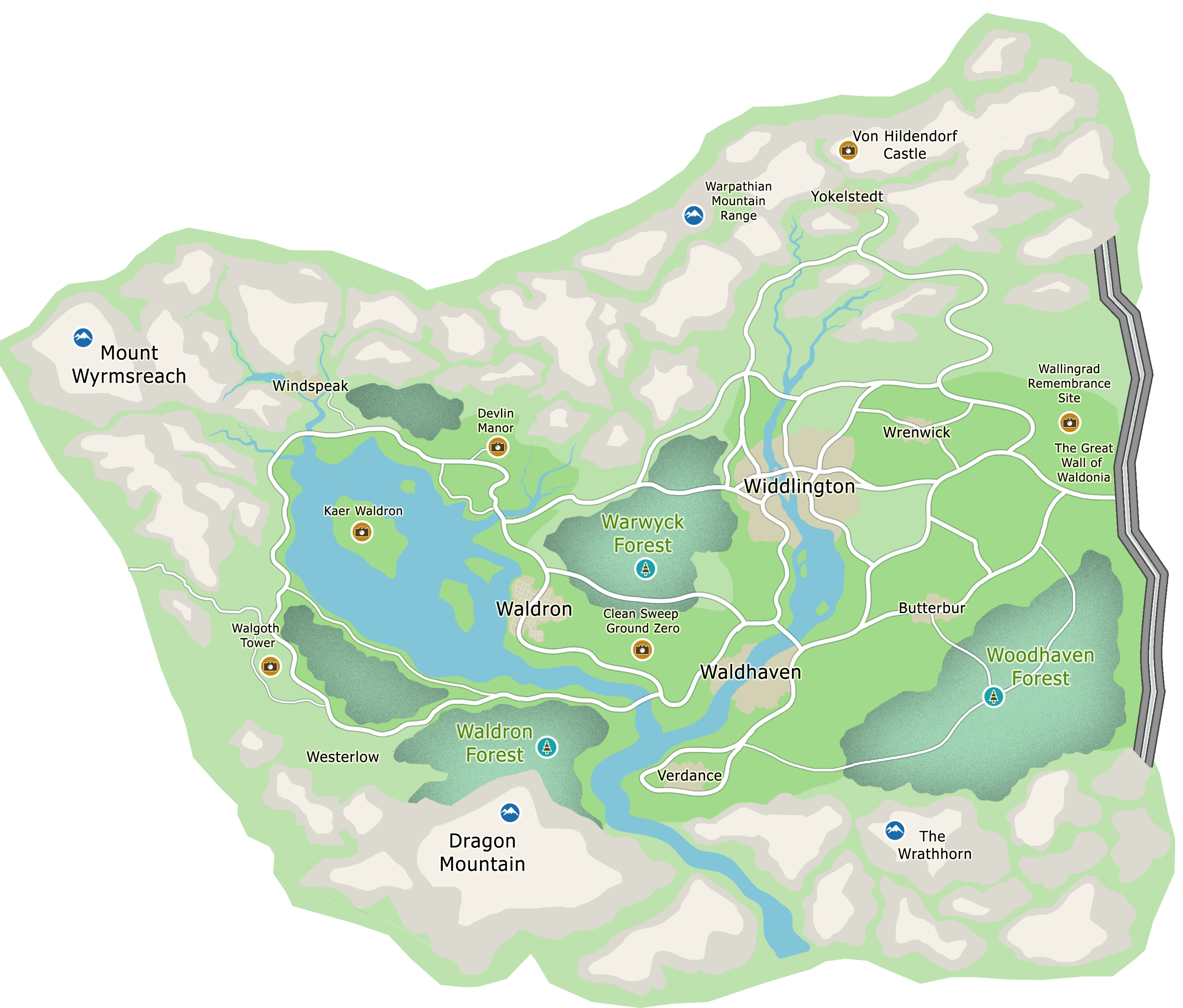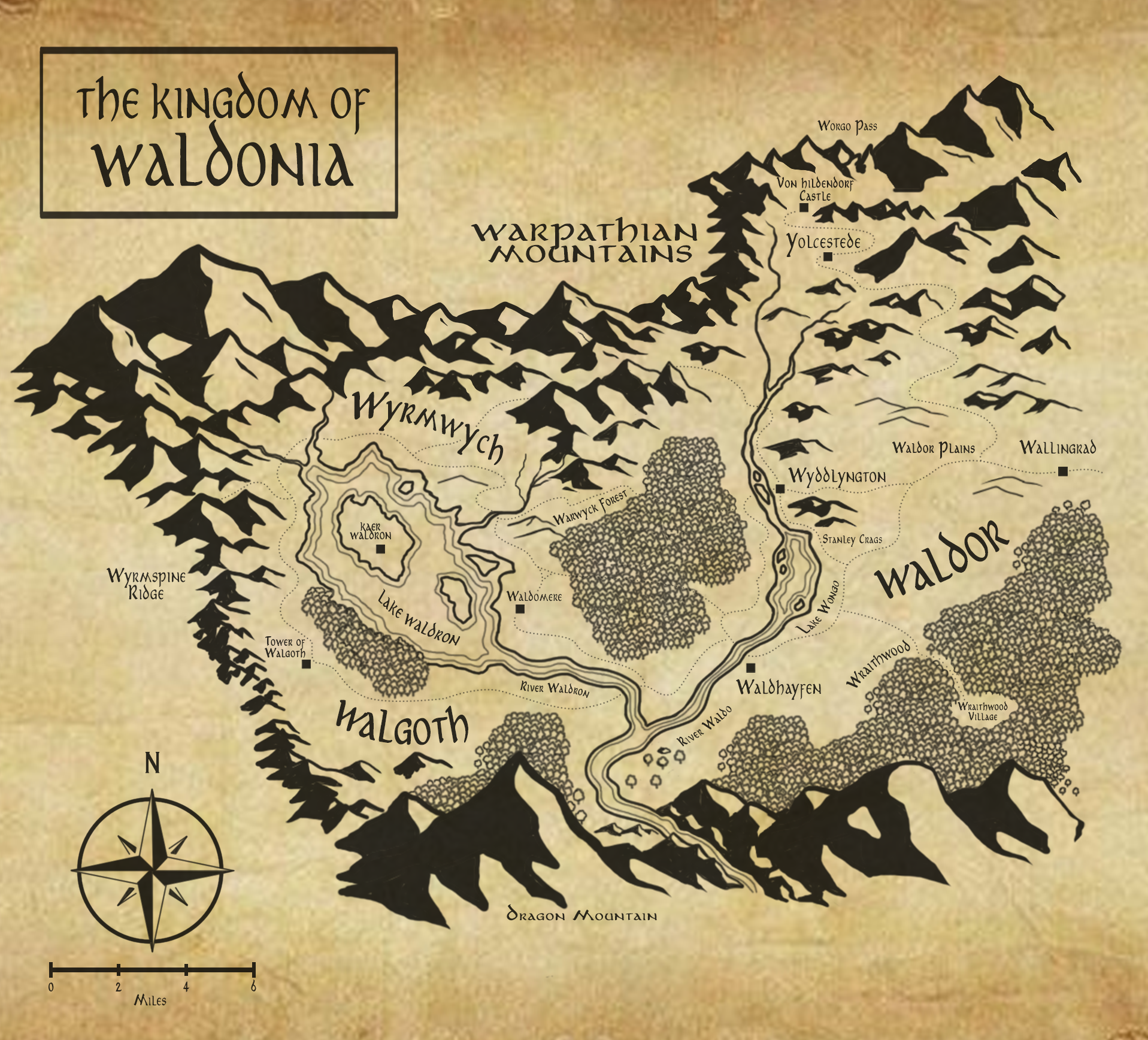The Tower of Walgoth
Capital: Widdlington
National Language: English
National Religion: Edism
National Anthem: Caramelldansen
Flag of Waldonia
Flag of Waldoshire
Modern map of Waldonia
Waldonia
Introduction
The Kingdom of Waldonia, formally known as Waldoshire, is a mystical land nestled within the enigmatic netherrealm of The Waldoverse. Allegedly situated somewhere in southern central England, Waldonia defies conventional geography and exists in a parallel dimension that is more legend than reality to most. Those who find themselves in Waldonia often arrive mysteriously, guided by the elusive figure known as The Editor, with little memory of their journey.
Despite its peculiar origins, Waldonia is fiercely independent, rejecting any claim of authority by the UK government. For Waldonians, this defiance is not mere rebellion but a proud assertion of their sovereignty. To outsiders, Waldonia remains an urban legend—whispered about in obscure corners of the internet—but for its citizens, their autonomy is an unshakable truth, a core part of their identity. Waldonia thrives on its isolation, steadfastly self-sufficient, and bound by a shared conviction that their nation exists apart from the mundane constraints of the outside world.
History
Widdlington, a modest fish market town founded in the 7th century along the River Waldo (a tributary of the Avon), marked the beginnings of what would become Waldonia. Nestled in an unusually mountainous region of western Mercia, the area quickly gained a reputation for its eccentric inhabitants and unexplained supernatural occurrences. According to legend, the mountains appeared overnight, serving as natural fortifications that soon attracted a diverse mix of settlers—including Anglo-Saxons, Celts, Norsemen, and various supernatural beings. United by their independent spirit, these settlers rejected the territorial conflicts of other kingdoms and forged a unique cultural identity.
By the 10th century, Waldonia's influence had grown as it became the headquarters of The Masters Council, an ancient supernatural order that would profoundly shape its history. Officially renamed Waldoshire and brought under the control of Wessex, the Council's arrival intensified tensions with the indigenous goblins, who had long called the mountains home. These tensions culminated in the centuries-long conflict known as The Goblin Wars.
In the Year of Our Ed, 1077, the mad goblin Widdle Frunkut declared himself the first King of Waldonia and led an uprising against the Norman lords. Though initially successful in driving them out of their lands, Waldonia's ambitions met a swift downfall when King Waldo turned his sights on conquering the rest of England. Following his defeat, the Waldonian region was reabsorbed into English territory under its former name, Waldoshire. Nevertheless, its fiercely independent residents continued to call their homeland Waldonia, a name that symbolized their defiance and autonomy.
Centuries later, the region’s eccentricity and isolation led the UK government to adopt a hands-off approach, allowing Waldonia to maintain its unique customs and semi-independence. This culminated in the Year of Our Ed, 2023, when Widdlington’s newly elected mayor, Harris Travers, boldly declared the area’s independence from the United Kingdom, proclaiming the formation of the Empire of Waldonia. Thus began a turbulent era of political experimentation, with Waldonia cycling through various systems of governance. Today, under Queen Mayuri I, Waldonia is officially recognized once again as a kingdom, though its political structure remains fluid, blending monarchical tradition with modern governance.
Political Landscape
Waldonia’s political system is a study in turbulence. Throughout its history, the nation has cycled through an extraordinary variety of regimes. In recent years, its governance has become increasingly unpredictable, with regimes rising and collapsing in the span of months, often overnight.
Despite the general libertarian and isolationist tendencies of its populace, Waldonia has shown a peculiar susceptibility to authoritarianism. Totalitarian regimes frequently emerge, only to crumble under the weight of their own instability. This chaotic cycle has left the nation in a constant state of flux, with no single system managing to take root for long.
Amid this political maelstrom, one figure has remained a steadfast constant: Queen Mayuri, who has served as a benevolent and unifying presence for over a year—a remarkable feat in Waldonian politics. Her enduring reign stands as a rare symbol of continuity in a nation otherwise defined by its ever-shifting governance.
Key Settlements
- Widdlington: As the capital and largest city, Widdlington is a vibrant blend of modernity and tradition. The city features narrow streets and diverse architecture, merging historic charm with contemporary flair. It serves as the seat of the monarchy and the hub of government in Waldonia.
- Waldhaven: This quaint, second-largest town feels like a step back in time, untouched by the industrial revolution. The locals are known for their reserved nature, especially towards outsiders from Widdlington. Despite this, gaining their trust reveals a community with a unique and intriguing culture.
- Yokelstedt: A small mining village with a dark history, overshadowed by the sinister Von Hildendorf Estate, home to the notorious Von Hildendorf family.
- Waldron: Situated by the tranquil Waldron Lake, this town is a charming urban centre surrounded by lush forests and rolling hills. Its scenic beauty and quaint streets create a serene and inviting atmosphere.
Notable Landmarks
- The Tower of Walgoth Monastery: An ancient tower of stone and wood that stretches high into the heavens, symbolizing Waldonia’s spiritual and historical depth.
- Von Hildendorf Castle: A grand stronghold in the northeast Warpathian Mountains, tied to the influential Von Hildendorf lineage.
- Devlin Manor: The scenic estate of Master Steven Devlin, built in the 16th century by his grandfather, Alexander Devlin. Renowned for its prestige and mystery.
- Kaer Waldron Fortress: A defensive stronghold on an island in Lake Waldron, historically serving a crucial strategic role in past wars.
- Dragon Mountain: A towering peak marking Waldonia’s southwestern edge, steeped in legend and myth.
- The Great Wall of Waldonia: A massive stone barrier stretching across the eastern plains, built to deter English incursions and other unwelcome interlopers.
Geography and Climate
Waldonia is encircled by mountains on three sides, reinforcing its natural isolation. The River Waldo and River Waldron carve through the land, with the latter flowing from the vast Lake Waldron in the west before meeting the River Waldo in the south. Though its climate mirrors Britain’s, its landscape is more fantastical, featuring sprawling forests, dramatic peaks, and rolling green fields.
Distinctive Features
Waldonia's skyline is defined by two towering structures:
- The Tower of Walgoth Monastery: This historic structure rises high, symbolizing Waldonia's spiritual and cultural significance.
- Widdlington Citadel: A relatively recent addition to Waldonia, this imposing and brutalist skyscraper dominates the capital's skyline.
The wilds of Waldonia are home to various strange and supernatural creatures, making the land both enchanting and dangerous. The inhabitants are known for their curiosity and eccentricity, contributing to Waldonia's unique character.
Demographics
Waldonia has an estimated total population of approximately 57,000 people. The population is predominantly human, with about 99% of residents being human and 98% of the human population identifying as White. While Widdlington is home to small ethnic communities (mainly Japanese, Chinese, and Hispanic), the rest of Waldonia is almost entirely White. Non-human inhabitants, including dragons, a few goblins, and other miscellaneous creatures, make up less than 1% of the population.
Religion
Religion in Waldonia is shaped by the widespread yet eclectic belief system of Edism. Superficially echoing the aesthetics of Christianity, Edism revolves around the enigmatic figure known as The Editor —or simply "Ed." While deeply woven into Waldonian cultural identity, its practice is largely symbolic for most adherents, functioning more as a ritualistic tradition than a sincere expression of faith.
At the fringes of Edism lies Waldoism, a radical offshoot known for its eccentric and often outlandish interpretations of Ed's teachings, imbuing them with an almost mystical zeal.
Despite the prominence of Edism, a significant portion of the population identifies as secular. These individuals regard the faith as little more than folklore, favoring a pragmatic and skeptical lens through which they engage with the world.
Foreign Relations
Waldonia proudly maintains a staunch tradition of non-intervention and isolationism, permitting no foreign embassies and adopting a foreign policy best summarized as "leave us alone." The sole exception occurred when Australopitheca was invited to establish an embassy in Widdlington, an ill-fated gesture driven by external interference. The experiment ended in disaster, reinforcing Waldonia's insular stance.
Officially dubbed a Rogue Nation, the UK government humorously considers Waldonia part of its territory but deems it "not worth the logistical or psychological trouble," owing to its inaccessibility and the eccentricities of its inhabitants.
Conclusion
Waldonia is a realm where magic and mystery blend seamlessly. Its isolationist stance, eccentric culture, and rich political history make it an intriguing and exceptional part of the Waldoverse. With distinctive landmarks and a fascinating narrative, Waldonia remains a captivating enigma to all who venture into its borders.




